Last updated on
Prefab homes can have rooftop solar panels, especially if designed for it. Panels can also be installed later on in most cases. Read on!
The trend is sustainable construction and prefab manufacturing. For this reason, many manufactured homes come equipped with solar panels. These panels can generate enough energy to power the home. In addition, these homes are typically built using recycled materials, making them environmentally friendly (zero-energy.)
Nonetheless, not all prefabs can support rooftop solar panels. The main reason is the house’s structure that needs to support the weight. Many cheaper and smaller prefabs don’t have the roof strength to support solar panels, but they can be installed in the backyard and use battery backups as an alternative.
Can You Install Rooftop Solar Power Panels on a Prefab Home?

It is possible to install rooftop solar panels on prefab homes in most cases. The key requirement for these homes is to have the correct joint strength and roof structure required to support the heavyweight of PV solar panels.
Typically, a strong enough roof is needed to install prefab home solar panels, and a permanent foundation is required. Thus, some types of prefabs (mobile homes, tiny houses, cabins) might not support solar panels.
How Much Money Can a Solar Roof Save You on Energy?
Normally, a residential solar setup generates anywhere between 350 and 850-kilowatt hours a month. According to the United States Energy Information Administration, on average, a home uses roughly 893-kilowatt hours of energy each month. Therefore, owning solar could save you 90 percent monthly on electric bills.
Solar Power in Manufactured Housing Communities
Various financing mechanisms like community solar programs have been enacted at the local and state levels to expand solar access across different populations. The key advantage of going solar for manufactured housing residents is cost savings. Often, low-income populations have a high energy burden, which indicates that a larger percentage of their household income funds energy expenses.
This can lessen the energy burden and free up much-needed funds for other essential expenses. Typically, manufactured homes have high electric loads and are energy inefficient, so with the right incentives and policies, the cost savings potential from solar energy could be quite significant.
Types of Solar Panels for a Manufactured Home

Below are three types of solar panels that can be used on manufactured homes:
Monocrystalline Panels
These cells are made from the purest silicon available. As such, panels constructed from these cells typically have the highest efficiency ratings of any panel available on the market and do extremely well with generating electricity.
Polycrystalline Panels
Where the manufacturer is concerned, polycrystalline panels are quicker to produce than any other kind of panel. They are a little less expensive to acquire compared to the monocrystalline options, for example.
They are also highly efficient, even though not as high quality as their monocrystalline counterparts. Even though this kind of panel may be reasonably priced, they are inferior to the monocrystalline panels related to the volume of power generated over a set period.
Amorphous Panels
Compared to the previous panels, these are a little more unique in that they are created from thin layers of silicon, which allows them to be bendable. They are also more lightweight than the other types of panels mentioned above.
Another great feature is that they can flawlessly function in low-light environments and under high temperatures. If you seek a solar module option designed to absorb a broad array of light spectrum, select the amorphous panels.
Grid vs Offgrid Solar Panels
As the name suggests, an on-grid or grid-tied solar energy system is attached to the utility grid. Off-grid solar energy systems are not attached to the utility grid. The choice you make between an on-grid system or an off-grid system will determine the access you will have to electricity, the equipment required for excess production, how you are billed for electricity, and what takes place when the grid is down.
How Many Solar Panels a Prefab Home Needs?
Most energy-efficient prefab homes range between 1,500 and 2,000 square feet; however, the power consumption widely varies. Typically, a prefab house might use up to 23,000 watts per day, with 80 percent of that amount from heating and cooling. A solar energy system of 10 x 300-watt panels might be sufficient to support that (assuming a 300W panel can produce 2.5kW per day if it receives 8 hours of sunlight.)
The Cost of Adding Solar Panels to a Manufactured Home
The cost of installing solar panels to a manufactured home can greatly vary based on the type and number of modules that will be installed. However, on average, a system for a manufactured home could cost roughly $20,000.
Incentives for Solar Power Installations
A federal ITC or investment tax credit for solar energy systems is established until December 31st, 2023. Commercial and residential customers alike can benefit from this tax credit. It applies to all three major kinds of solar technology: concentrating solar, solar heating and cooling, and photovoltaic technology. Besides the federal ITC, rebates or other incentives are offered by many utilities, municipalities, counties, and states for solar energy technologies.
Solar Panels on a Mobile Home
Typically, rooftop solar panels are not an option for mobile homes. In contrast to site-built houses, mobile homes are not designed structurally to support a PV panel installation. This kind of housing has tinier roof joists, which are not sufficiently strong to support the photovoltaic array’s mass safely.
However, there could be an option to use another structure to install the rooftop PV panel. Storage shed, enclosed patio, or garage could have the structural integrity to support a photovoltaic array.
If no other suitable building is available, there is the option of adopting solar power via a ground-mounted PV installation. Typically, this system is the wisest option for a prefab home. Since it can be put in the most beneficial position, maximum energy production can be expected.
Better Efficiency from a Mobile Home Solar System
You can get better efficiency from a mobile home solar system by purchasing panels with highly concentrated photovoltaic cells. The finest conventional solar panels peak at 22 percent efficiency, while the CPV panel cells can attain 46 percent efficiency.
Additionally, you can purchase a more efficient model of solar panel. You should also avoid installing the panels in shaded areas. This is because solar panels produce electricity from sunlight; therefore, the shade will harm the output of the electricity.
How Much Solar Power Does a Mobile Home Need?
A mobile home requires a 2 x 300W solar panel system. On average, this can generate 5,000 watts per day (assuming 8 hours of sunlight), which is adequate for a home that uses basic appliances and is between 500 and 780 square feet.
Table of Contents




